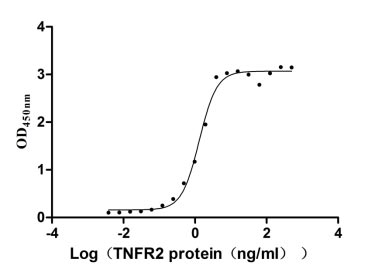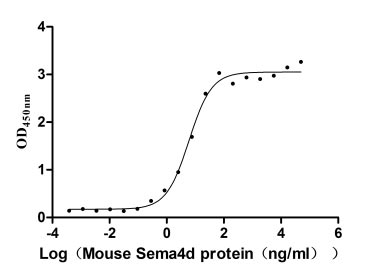Recombinant Saccharomyces cerevisiae Transcription initiation factor TFIID subunit 14 (TAF14)
-
货号:CSB-YP330435SVG
-
规格:
-
来源:Yeast
-
其他:
-
货号:CSB-EP330435SVG
-
规格:
-
来源:E.coli
-
其他:
-
货号:CSB-EP330435SVG-B
-
规格:
-
来源:E.coli
-
共轭:Avi-tag Biotinylated
E. coli biotin ligase (BirA) is highly specific in covalently attaching biotin to the 15 amino acid AviTag peptide. This recombinant protein was biotinylated in vivo by AviTag-BirA technology, which method is BriA catalyzes amide linkage between the biotin and the specific lysine of the AviTag.
-
其他:
-
货号:CSB-BP330435SVG
-
规格:
-
来源:Baculovirus
-
其他:
-
货号:CSB-MP330435SVG
-
规格:
-
来源:Mammalian cell
-
其他:
产品详情
-
纯度:>85% (SDS-PAGE)
-
基因名:TAF14
-
Uniprot No.:
-
别名:TAF14; ANC1; CST10; SWP29; TAF30; TFG3; YPL129W; Transcription initiation factor TFIID subunit 14; Actin non-complementing mutant 1; Chromosome stability protein 10; SWI/SNF chromatin-remodeling complex subunit TAF14; SWI/SNF complex 29 kDa subunit; SWI/SNF complex subunit TAF14; TBP-associated factor 14; TBP-associated factor 30 kDa; Transcription factor G 30 kDa subunit; Transcription initiation factor TFIIF 30 kDa subunit
-
种属:Saccharomyces cerevisiae (strain ATCC 204508 / S288c) (Baker's yeast)
-
蛋白长度:full length protein
-
表达区域:1-244
-
氨基酸序列MVATVKRTIR IKTQQHILPE VPPVENFPVR QWSIEIVLLD DEGKEIPATI FDKVIYHLHP TFANPNRTFT DPPFRIEEQG WGGFPLDISV FLLEKAGERK IPHDLNFLQE SYEVEHVIQI PLNKPLLTEE LAKSGSTEET TANTGTIGKR RTTTNTTAEP KAKRAKTGSA STVKGSVDLE KLAFGLTKLN EDDLVGVVQM VTDNKTPEMN VTNNVEEGEF IIDLYSLPEG LLKSLWDYVK KNTE
-
蛋白标签:Tag type will be determined during the manufacturing process.
The tag type will be determined during production process. If you have specified tag type, please tell us and we will develop the specified tag preferentially. -
产品提供形式:Lyophilized powder
Note: We will preferentially ship the format that we have in stock, however, if you have any special requirement for the format, please remark your requirement when placing the order, we will prepare according to your demand. -
复溶:We recommend that this vial be briefly centrifuged prior to opening to bring the contents to the bottom. Please reconstitute protein in deionized sterile water to a concentration of 0.1-1.0 mg/mL.We recommend to add 5-50% of glycerol (final concentration) and aliquot for long-term storage at -20℃/-80℃. Our default final concentration of glycerol is 50%. Customers could use it as reference.
-
储存条件:Store at -20°C/-80°C upon receipt, aliquoting is necessary for mutiple use. Avoid repeated freeze-thaw cycles.
-
保质期:The shelf life is related to many factors, storage state, buffer ingredients, storage temperature and the stability of the protein itself.
Generally, the shelf life of liquid form is 6 months at -20°C/-80°C. The shelf life of lyophilized form is 12 months at -20°C/-80°C. -
货期:Delivery time may differ from different purchasing way or location, please kindly consult your local distributors for specific delivery time.Note: All of our proteins are default shipped with normal blue ice packs, if you request to ship with dry ice, please communicate with us in advance and extra fees will be charged.
-
注意事项:Repeated freezing and thawing is not recommended. Store working aliquots at 4°C for up to one week.
-
Datasheet :Please contact us to get it.
靶点详情
-
功能:Functions as a component of the DNA-binding general transcription factor complex TFIID, the RNA polymerase II associated general transcription factor complex TFIIF, and the chromatin-remodeling complex SWI/SNF. Binding of TFIID to a promoter (with or without TATA element) is the initial step in preinitiation complex (PIC) formation. TFIID plays a key role in the regulation of gene expression by RNA polymerase II through different activities such as transcription activator interaction, core promoter recognition and selectivity, TFIIA and TFIIB interaction, chromatin modification (histone acetylation by TAF1), facilitation of DNA opening and initiation of transcription. TFIIF is essential for the initiation of transcription by RNA polymerase II. TFIIF functions include the recruitment of RNA polymerase II to the promoter bound DNA-TBP-TFIIB complex, decreasing the affinity of RNA polymerase II for non-specific DNA, allowing for the subsequent recruitment of TFIIE and TFIIH, and facilitating RNA polymerase II elongation. TAF14 acts as a chromatin reader that specifically recognizes and binds histones that are acylated. Recognizes and binds histone H3 acetylated or crotonylated at 'Lys-9' (H3K9ac and H3K9cr, respectively), with some preference for crotonylated lysine. Component of the SWI/SNF complex, an ATP-dependent chromatin-remodeling complex, is required for the positive and negative regulation of gene expression of a large number of genes. It changes chromatin structure by altering DNA-histone contacts within a nucleosome, leading eventually to a change in nucleosome position, thus facilitating or repressing binding of gene-specific transcription factors. Component of the histone acetyltransferase NuA3 complex, that acetylates Lys-14 of histone H3. Recruitment of NuA3 to nucleosomes requires methylated histone H3. In conjunction with the FACT complex, NuA3 may be involved in transcriptional regulation. Does not bind DNA.
-
基因功能参考文献:
- a novel role for Taf14 in repression and derepression of stress induced genes PMID: 28209126
- the YEATS domain of Taf14, a member of key transcriptional and chromatin-modifying complexes in yeast, is a selective reader of histone H3 Lys9 acetylation (H3K9ac). PMID: 26341557
- Taf14 is involved in transcriptional activation of Saccharomyces cerevisiae and the YEATS domain of Taf14 might play a negative role in cell growth. PMID: 21355849
- show here that the YEATS domain is not necessary for Taf14's association with transcription stimulatory activity and chromatin remodeling complexes. PMID: 20179968
- ANC1 is in the same epistasis group as SRS2 and RAD5; ANC1 defines a new error-free branch of the postreplication repair pathway; intact ANC1 gene significantly suppresses spontaneous mutation rates, including the expansion of (CAG)(25) repeats PMID: 19005567
显示更多
收起更多
-
亚细胞定位:Nucleus.
-
蛋白家族:TAF14 family
-
数据库链接:
KEGG: sce:YPL129W
STRING: 4932.YPL129W
Most popular with customers
-
Recombinant Human Tumor necrosis factor receptor superfamily member 1B (TNFRSF1B), partial (Active)
Express system: Mammalian cell
Species: Homo sapiens (Human)
-
Recombinant Mouse Semaphorin-4D (Sema4d), partial (Active)
Express system: Mammalian cell
Species: Mus musculus (Mouse)
-
Recombinant Dog Angiopoietin-2 (ANGPT2) (Active)
Express system: Mammalian cell
Species: Canis lupus familiaris (Dog) (Canis familiaris)
-
Recombinant Mouse Complement component C1q receptor (Cd93), partial (Active)
Express system: Mammalian cell
Species: Mus musculus (Mouse)
-
Recombinant Human Trophoblast glycoprotein (TPBG), partial (Active)
Express system: Mammalian cell
Species: Homo sapiens (Human)
-
Recombinant Human C-C chemokine receptor type 8 (CCR8)-VLPs (Active)
Express system: Mammalian cell
Species: Homo sapiens (Human)
-
Recombinant Human Interleukin-2 receptor subunit alpha (IL2RA), partial (Active)
Express system: Mammalian cell
Species: Homo sapiens (Human)
-
Recombinant Human Interleukin-2 (IL2) (Active)
Express system: Mammalian cell
Species: Homo sapiens (Human)




















